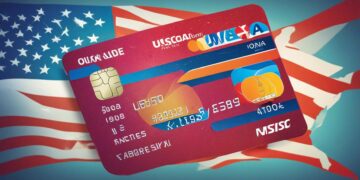Introductory 0% Interest Credit Cards in the USA: How They Work

Understanding Introductory 0% Interest Credit Cards
Introductory 0% interest credit cards have become a prominent financial tool in the United States, drawing attention from both experienced credit users and those venturing into the world of credit for the first time. These cards provide a much-needed break from interest charges, enabling consumers to manage their spending and existing debts with greater flexibility. Many find that these cards can be a useful strategy for budgeting, debt reduction, and improving their credit health.
Key Features of 0% Interest Credit Cards
One of the standout features of these cards is the Promotional Period, typically lasting between 6 to 18 months. During this period, cardholders enjoy 0% interest on both purchases and balance transfers, which can lead to substantial savings. For example, if someone transfers a balance of $5,000 from a card with a 20% APR, they could avoid paying hundreds of dollars in interest during the promotional period.
- Balance Transfers: These credit cards often facilitate balance transfers from other accounts, allowing users to consolidate their debt under one manageable interest rate—essentially, zero percent. This can be particularly advantageous for managing credit card debt, which often accrues rapidly due to high interest rates.
- No Annual Fees: Many introductory 0% interest cards come without an annual fee, enhancing their budget-friendly appeal. By avoiding this upfront cost, consumers can save even more money while benefiting from the card’s features.
Potential Drawbacks and Responsibilities
While the benefits of these cards can be significant, it is vital to be aware of certain conditions that could potentially negate the advantages. For instance, late payments can trigger penalties and often lead to an increase in the interest rate, reverting it to a high standard APR. Users are also encouraged to monitor their spending closely, as exceeding the credit limit can similarly result in unforeseen charges. Keeping track of due dates and maintaining a low balance relative to the credit limit can safeguard against these pitfalls.
Maximizing the Benefits
Exploring various credit card options can reveal unique rewards tailored to individual financial situations. For instance, some cards may offer additional perks like cashback on certain purchases or travel rewards. With careful planning and a commitment to responsible usage, introductory 0% interest credit cards can serve as a powerful resource in anyone’s financial toolkit, aiding in everything from large purchases to strategic debt repayment.
In conclusion, these cards are not merely a promotional gimmick; they can be an essential financial tool when used correctly. Researching, understanding the fine print, and utilizing the benefits effectively can lead to improved financial stability and even credit score enhancement.
SEE ALSO: Click here to read another article
How Introductory 0% Interest Credit Cards Function
At their core, introductory 0% interest credit cards are designed to provide financial relief by allowing consumers to make purchases or transfer existing balances without accruing interest for a set period. This unique feature is particularly attractive in an environment where the average credit card interest rate hovers around 20%, making the potential savings from these promotional offers quite significant. But how exactly do these cards work?
The Mechanics Behind 0% Interest Offers
The 0% interest promotion typically covers a specified duration, ranging from 6 to 18 months. During this time, cardholders benefit from no interest on new purchases and balance transfers made to the card. This feature can dramatically affect one’s financial situation, especially if you aim to pay down high-interest debt or finance a large purchase without the immediate burden of interest accumulation.
To illustrate, consider a scenario where an individual has $3,000 in credit card debt incurring a 22% interest rate. By transferring that balance to a 0% interest card with a 12-month promotional period, the consumer can avoid approximately $660 in interest, allowing their payments to go directly towards reducing principal during that time.
Common Features to Look For
While the allure of 0% interest is paramount, understanding other key features can enhance decision-making. When evaluating potential credit cards, consider the following:
- Length of the Promotional Period: Some cards offer longer promotional periods than others. A longer duration can be particularly beneficial for those aiming to pay off larger debts or make substantial purchases.
- Balance Transfer Fees: Many cards impose transfer fees, typically ranging from 3% to 5% of the transferred amount. Understanding these fees is crucial, as they could cut into the savings gained from the interest-free promotion.
- Regular APR Post-Promotion: After the promotional period ends, be aware of the card’s standard annual percentage rate (APR), as this will play a significant role in your financial strategy moving forward. An unexpectedly high rate could lead to increased financial strain.
Additionally, some cards may offer innovative features like reward points or cashback benefits, which can further enhance their appeal. This flexibility allows consumers to not only manage their current financial obligations but also potentially earn rewards on purchases during the promotional phase.
Understanding how these introductory 0% interest credit cards function can empower consumers to make informed decisions, helping them leverage these tools to improve their financial landscape. A little research and strategic planning can lead to significant savings and increased credit health in the long run.
SEE ALSO: Click here to read another article
Repayment Strategies and Potential Pitfalls
While the benefits of introductory 0% interest credit cards can be enticing, it’s crucial to approach them with a well-thought-out repayment strategy. The essence of these promotions lies in their capricious nature; if not managed properly, the financial relief they provide can quickly transform into a burden.
Crafting a Repayment Plan
To fully capitalize on the advantages of a 0% interest card, craft a repayment plan that aligns with the promotional timeline. Begin by assessing your financial situation. Calculate your monthly budget to determine how much you can allocate towards paying down the balance. For instance, if you transfer a balance of $5,000 to a card with a 12-month 0% interest period, aim to pay off approximately $416 each month. This proactive approach ensures you won’t be left with a significant balance once the promotional period expires.
Moreover, paying more than the minimum monthly payment can help prevent the dreaded cycle of debt. Once the promotional period concludes, any remaining balance will accrue interest at the standard APR, which, as mentioned earlier, can be deceptively high. For those who may find themselves still carrying a balance post-introductory phase, transitioning to a low-interest card or exploring refinancing options might be prudent to avoid accumulating additional interest.
Avoiding Common Pitfalls
As with any financial product, pitfalls can lurk in the shadows. One common error is assuming that the 0% interest offer is valid for the entire duration of the promotional period. In reality, many consumers inadvertently overlook the stipulation that requires timely payments. Late payments can lead to losing the promotional rate and may trigger a higher standard APR. It’s essential to be diligent in meeting payment deadlines to fully benefit from the introductory offer.
Another consideration is the notion that you can completely rely on the promotional offer for all your purchases. Racking up new debt on your 0% interest card can be a slippery slope. By using the card for everyday transactions without a repayment strategy in place, you risk creating a balance that could leave you vulnerable once the interest-free period ends. It’s wise to use the card sparingly for necessities while focusing on paying down any existing debt.
Comparing Options before Committing
Consumers should also take the time to compare various credit card offers before making a decision. Not all 0% interest cards are created equal. For instance, a card with a shorter 0% period may have no transfer fees or a lower post-promotional APR, making it a better option than one with a longer interest-free duration laden with hefty fees. Additionally, some cards may even offer perks like travel rewards or cash back during the promotional period, potentially adding more value for savvy consumers.
By thoroughly investigating all available options and dissecting the terms and conditions, you can better position yourself to take full advantage of an introductory 0% interest credit card. This understanding not only allows you to manage your current debt more effectively but also opens doors to sound financial practices and long-term wellness.
CHECK OUT: Click here to explore more
Final Thoughts
In conclusion, introductory 0% interest credit cards present a unique opportunity for consumers to manage debt and make substantial purchases without the immediate burden of interest. When utilized wisely, these financial tools can be an asset, allowing individuals to pay down existing debts efficiently or to fund necessary expenses without incurring additional costs during the promotional period. However, it is essential to recognize that the potential rewards come with the caveat of responsibility. To maximize the benefits of these cards, one must approach them with a clear understanding of the terms and a solid repayment plan.
Staying alert to deadlines, ensuring timely payments, and avoiding new accumulation of debt on these cards are pivotal steps in navigating the landscape of introductory offers. Moreover, consumers must engage in diligent comparisons of card options to find the one that best fits their financial situation, as not all offers provide equal benefits. By being informed and strategic, American consumers can take advantage of the perks of 0% interest cards while steering clear of common pitfalls.
Ultimately, an introductory 0% interest credit card can serve as a gateway to improved financial health and debt management when used thoughtfully. As you consider your options, remember that understanding the nuances of these offers can illuminate your path toward a more secure financial future. The world of credit can be complex, but with the right tools and strategies, you can navigate it with confidence.






